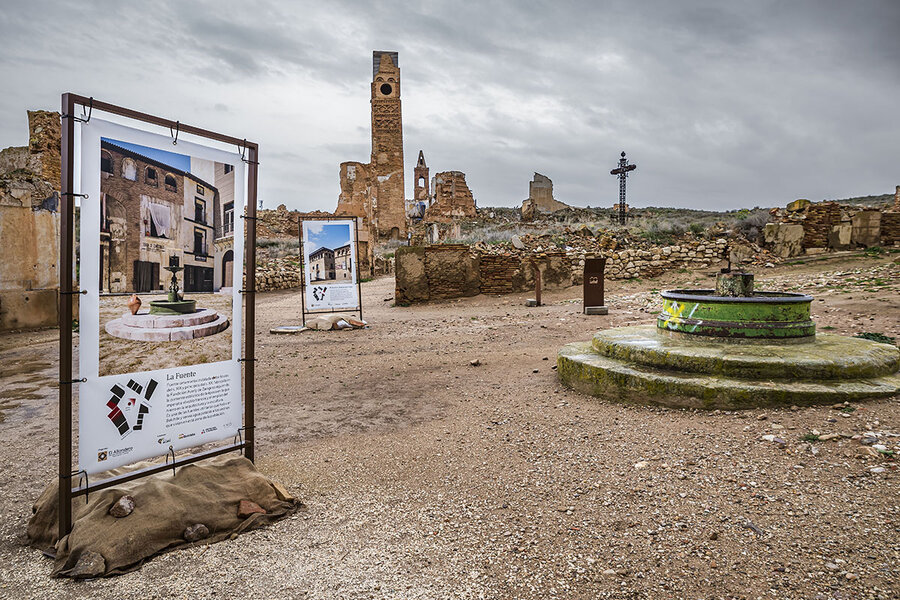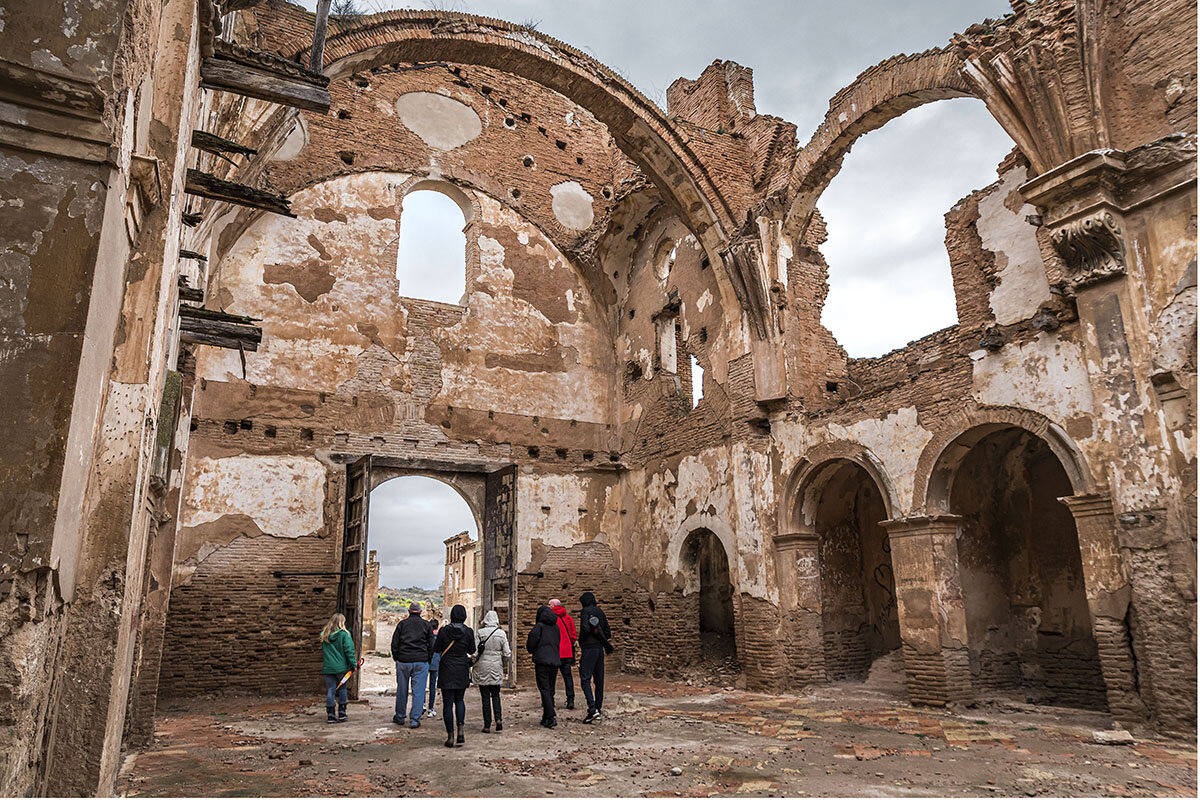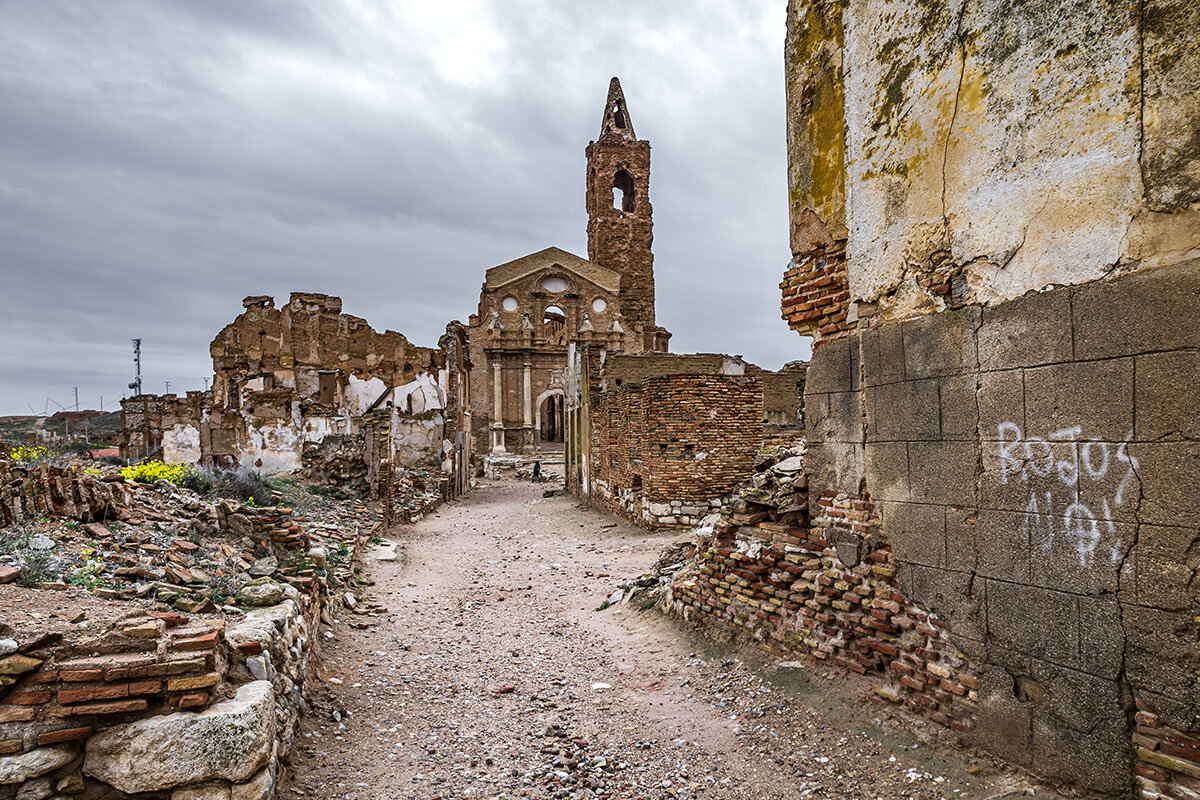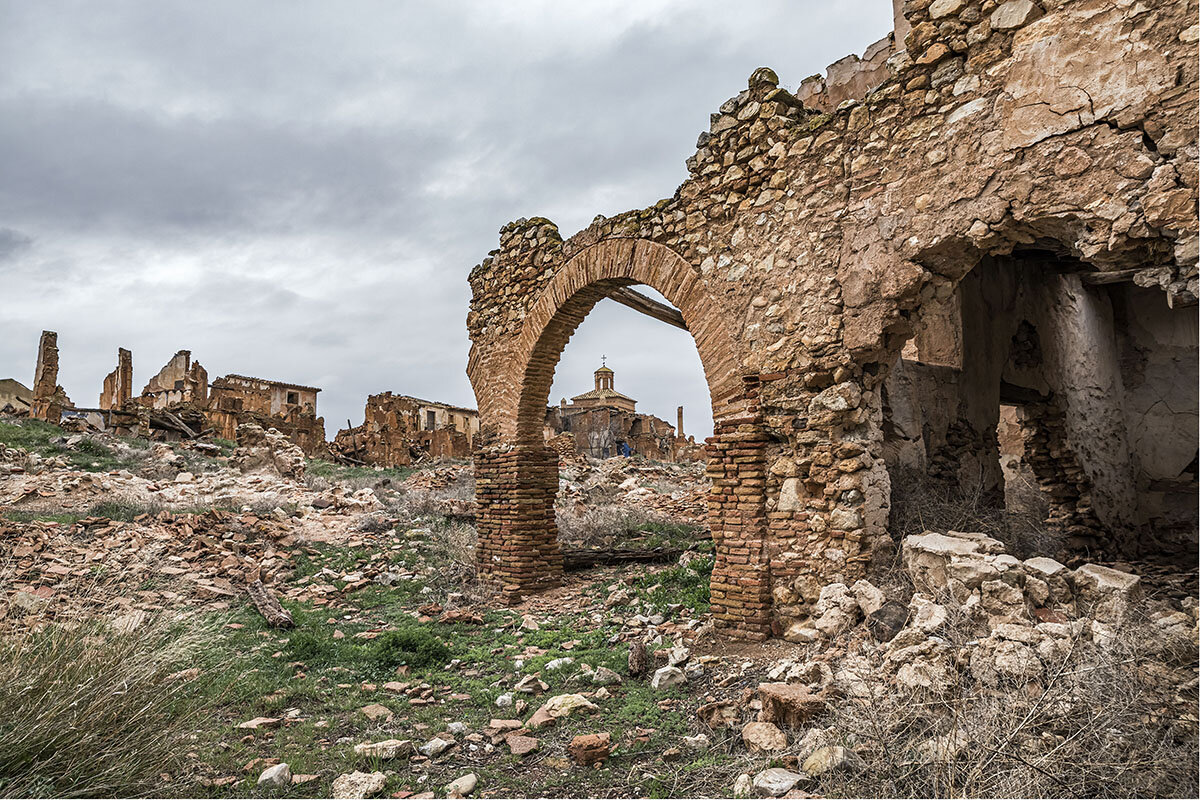Images from Ukraine resonate on visit to ‘living ruin’ in Spain
Loading...
| Belchite, Spain
Laura Soriano opens the thick wooden doors and invites us through. The facade, which bears the words in Spanish, “Blasphemy is Prohibited,” dates to the 18th century, and as we begin our tour I assume we are entering a church.
But stepping inside there are no walls. Instead, the arched doorway opens onto a street, now a dirt road, where homes, churches, a theater, dance hall, and bank stood before the Battle of Belchite in 1937. And it has sat like this for more than 80 years – a time capsule of utter wreckage and ruination.
At any time a contrast so stark and tangible – stepping from peace to war – would be disconcerting, but coming two weeks after the Russian invasion of Ukraine made it feel even heavier, and our tour guide was quick to draw the parallels. Just as Russian bombs had destroyed a maternity ward in Mariupol – and were later to strike a theater where Ukrainians had taken refuge – so had destruction rained down on civilians here.
Why We Wrote This
Our reporter explores a battlefield in Spain that is a time capsule of a devastated city, a visit conducted in the shadows of another land war in Europe.
Ms. Soriano points to the basement of a crumbled home. “That’s where women and children sought safety,” she says, “the same thing happening now in Ukraine.”
Belchite isn’t the most well-known battle of the Spanish Civil War, which began in 1936 with a coup led by Gen. Francisco Franco. But it’s one of the few places in contemporary Spain where you can feel the horrors of the war, not just read about it, visit a memorial, or see it depicted in art or film. And the site’s own evolution in meaning to Spain may point to a political maturation underway as societies confront their pasts and the ideologies that have torn them apart.
Tucked in the barren hills of Aragon in northeastern Spain, Belchite was initially controlled by Franco’s Nationalist forces, before it fell to the Republicans in August 1937 during a 14-day battle that became an international symbol of Spain’s divisions. It also exemplified the polarized politics of Europe in the 1930s.
Six months later, Franco’s forces retook Belchite.
About 5,000 died on both sides. But Franco decided to keep Belchite in ruins instead of razing it to rebuild. It was an act of propaganda: The dictator eventually built a new town next door, while leaving the old one untouched as a constant reminder of the barbarism of his enemies.
It was not a memorial to the dead or an act of peace. “At no point in the near 40 years of dictatorship did Franco have the slightest interest in what we might call reconciliation,” says Paul Preston, a renowned historian of the Spanish Civil War and author of “The Spanish Holocaust,” among other books on the conflict.
But Franco’s “living ruins” eventually did become a symbol for peace, and for many a stark expression of the barbarism of fascism.
In the early year of Spain’s transition to democracy after the death of Franco in 1975, the site of Belchite slipped into obscurity, says local resident Juan Carlos Salavera Pardos, who administers a Facebook page called “Belchite, Between Oblivion and Memory.” It’s only in recent years it’s emerged as an anti-war monument.
Bearing witness
Walking through the abandoned town gives a sense of bearing witness on this day as heavy storm clouds gather. Bullet holes mark the facades. At one of the standing churches, visitors must tread carefully because gaping holes from missiles have made parts of the roof unstable.
The acts of war from 80 years ago continue to mark lives here. A mass grave was uncovered last fall, and two weeks before our visit in March a bomb lodged high up into the wall of the cathedral was finally removed. All these years later, authorities discovered it had been active this whole time.
Spain has had an uncomfortable relationship with the legacy of its civil war – preferring to forget it rather than confront it. For years Belchite was an open site and anyone could roam around; many took away materials from roofs and old doorways. Growing up here, Ms. Soriano didn’t learn anything at school about the battle site.
Today it’s open to guided tours, and Ms. Soriano tells the complex history of damage wrought by both sides. School groups often join her tours, she says, to learn about conflict resolution and empathy-building. They talk about current wars. She says they will be redesigning the curriculum to include Russia’s invasion of Ukraine.
David Malet, an associate professor of justice at American University who studies foreign fighters, says he sees an evolution in postwar societies. The norm used to be that killing sites were maintained to remind us of what “they” did, but it’s become common for societies to memorialize sites that remind “us” of what “we” did. He sees this transition as a sign of “political maturity.”
The new town of Belchite is a bustling place – a typical Spanish town where seniors pack the cafes at midmorning. But the memory of war has always been close. In a town of 1,500, almost everyone carries a story about the 14-day siege.
As Ms. Soriano recounts the names of owners of various houses and businesses in old Belchite, these are not just the names of historic figures but people her great-grandparents knew. Her grandmother, who just turned 89, was 4 years old during the Battle of Belchite. “She was just asking us at lunch yesterday, ‘How can war in Europe be happening again?’”
“For me,” says Ms. Soriano, “it pains me to see what families are going through, everyone leaving their partners, their spouses. They don’t know if they will live or die. They don’t know where they will be going or where they will be ending up. They just know they are far from home, and they don’t know if they will have a home if they return,” she says. “I do think we feel it closer here.”











